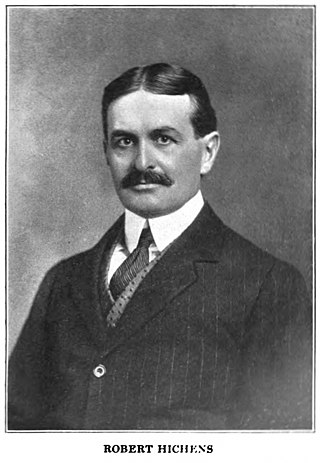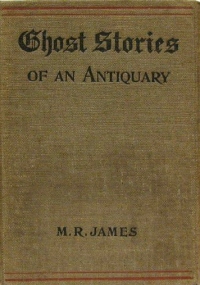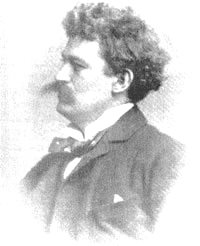
Montague Rhodes James was an English medievalist scholar and author who served as provost of King's College, Cambridge (1905–1918), and of Eton College (1918–1936) as well as Vice-Chancellor of the University of Cambridge (1913–1915). James's scholarly work is still highly regarded, but he is best remembered for his ghost stories, which are considered by many critics and authors as the finest in the English language and widely influential on modern horror.

William Hope Hodgson was an English author. He produced a large body of work, consisting of essays, short fiction, and novels, spanning several overlapping genres including horror, fantastic fiction, and science fiction. Hodgson used his experiences at sea to lend authentic detail to his short horror stories, many of which are set on the ocean, including his series of linked tales forming the "Sargasso Sea Stories". His novels, such as The House on the Borderland (1908) and The Night Land (1912), feature more cosmic themes, but several of his novels also focus on horrors associated with the sea. Early in his writing career Hodgson dedicated effort to poetry, although few of his poems were published during his lifetime. He also attracted some notice as a photographer and achieved renown as a bodybuilder. He died in World War I at age 40.

Edward Frederic Benson was an English novelist, biographer, memoirist, historian and short story writer.

Robert William Chambers was an American artist and fiction writer, best known for his book of short stories titled The King in Yellow, published in 1895.

George Oliver Onions, who published under the name Oliver Onions, was an English writer of short stories and novels. He wrote in various genres, but is perhaps best remembered for his ghost stories, notably the collection Widdershins and the widely anthologized novella "The Beckoning Fair One". He was married to the novelist Berta Ruck.

Guy Newell Boothby was a prolific Australian novelist and writer, noted for sensational fiction in variety magazines around the end of the nineteenth century. He lived mainly in England. He is best known for such works as the Dr Nikola series, about an occultist criminal mastermind who is a Victorian forerunner to Fu Manchu, and Pharos, the Egyptian, a tale of Gothic Egypt, mummies' curses and supernatural revenge. Rudyard Kipling was his friend and mentor, and his books were remembered with affection by George Orwell.

Robert Hugh Monsignor Benson AFSC KC*SG KGCHS was an English Catholic priest and writer. First an Anglican priest, he was received into the Catholic Church in 1903 and ordained therein the next year. He was also a prolific writer of fiction, writing the notable dystopian novel Lord of the World, as well as Come Rack! Come Rope!.

Arthur Reed Ropes, better known under the pseudonym Adrian Ross, was a prolific writer of lyrics, contributing songs to more than sixty British musical comedies in the late 19th and early 20th centuries. He was the most important lyricist of the British stage during a career that spanned five decades. At a time when few shows had long runs, nineteen of his West End shows ran for over 400 performances.

Sir Max Pemberton was a popular English novelist and publisher working mainly in the adventure and mystery genres.

Robert Smythe Hichens was an English journalist, novelist, music lyricist, short story writer, music critic and collaborated on successful plays. He is best remembered as a satirist of the "Naughty Nineties".

Ghost Stories of an Antiquary is a collection of ghost stories by British writer M. R. James, published in 1904. Some later editions under this title contain both the original collection and its successor, More Ghost Stories (1911), combined in one volume.
Alfred McLelland Burrage (1889–1956) was a British writer. He was noted in his time as an author of fiction for boys which he published under the pseudonym Frank Lelland, including a popular series called "Tufty". After his death, however, Burrage became best known for his ghost stories.
Evelyn Charles Henry Vivian was the pseudonym of Charles Henry Cannell, a British editor and writer of fantasy and supernatural, detective novels and stories.

Bertram Fletcher Robinson was an English sportsman, journalist, editor, author and Liberal Unionist Party activist. During his life-time, he wrote at least three hundred items, including a series of short stories that feature a detective called 'Addington Peace'. Following his untimely death at the age of just 36 years, speculation grew that Robinson was the victim of a curse bestowed upon him by an Egyptian antiquity at the British Museum, which he had researched whilst working as a journalist for a British newspaper. However, Robinson is perhaps best remembered for his literary collaborations with his friends and fellow Crimes Club members, Arthur Conan Doyle, P. G. Wodehouse and Max Pemberton.

Cassell's Magazine is a British magazine that was published monthly from 1897 to 1912. It was the successor to Cassell's Illustrated Family Paper, (1853–1867) becoming Cassell's Family Magazine in 1874, Cassell's Magazine in 1897, and, after 1912, Cassell's Magazine of Fiction.

Henry Brereton Marriott Watson, known by his pen name H. B. Marriott Watson, was an Australian-born British novelist, journalist, playwright, and short-story writer. He worked for the St. James Gazette, was assistant editor of the Black and White and Pall Mall Gazette, and staff member on W. E. Henley's National Observer.

The Grand Magazine was the first British pulp magazine. It was published monthly between February 1905 and April 1940. Published by George Newnes Ltd, it initially emulated Newnes's highly successful Strand Magazine, featuring a mix of fiction and non-fiction. In 1908, it was renamed The Grand Magazine of Fiction.
Tom Bevan, who also wrote under the pseudonym Walter Bamfylde, was a British writer of boys' adventure stories. Originally a schoolteacher, he also wrote non-fiction books for children.
Henrietta Dorothy Everett, who wrote under the pen name Theo Douglas, was a British novelist who was popular during her lifetime but who is now largely forgotten. Her identity was revealed in 1910 but little is known of her life.

George Newnes Ltd is a British publisher. The company was founded in 1891 by George Newnes (1851–1910), considered a founding father of popular journalism. Newnes published such magazines and periodicals as Tit-Bits, The Wide World Magazine, The Captain, The Strand Magazine, The Grand Magazine, John O'London's Weekly, Sunny Stories for Little Folk, Woman's Own, and the "Practical" line of magazines overseen by editor Frederick J. Camm. Long after the founder's death, Newnes was known for publishing ground-breaking consumer magazines such as Nova.
















